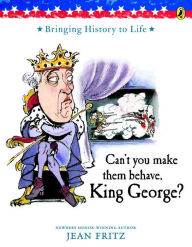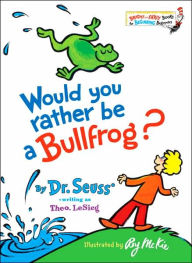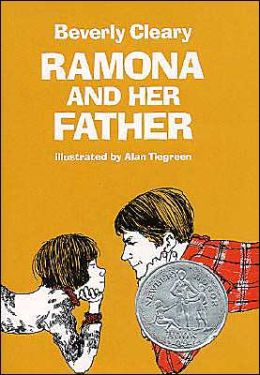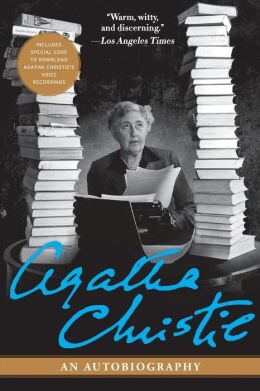new posts in all blogs
Viewing: Blog Posts Tagged with: 1977, Most Recent at Top [Help]
Results 1 - 7 of 7
How to use this Page
You are viewing the most recent posts tagged with the words: 1977 in the JacketFlap blog reader. What is a tag? Think of a tag as a keyword or category label. Tags can both help you find posts on JacketFlap.com as well as provide an easy way for you to "remember" and classify posts for later recall. Try adding a tag yourself by clicking "Add a tag" below a post's header. Scroll down through the list of Recent Posts in the left column and click on a post title that sounds interesting. You can view all posts from a specific blog by clicking the Blog name in the right column, or you can click a 'More Posts from this Blog' link in any individual post.
Can't You Make Them Behave, King George? Jean Fritz. Illustrated by Tomie dePaola. 1977/1996. 48 pages. [Source: Library]
I am so glad I read Jean Fritz's Can't You Make Them Behave, King George? I found this one to be a delight. And not just because I happen to
love Horrible Histories' Born 2 Rule. (I should probably make that love, love, love, LOVE. I love Horrible Histories, the show in general, and the songs very, very much.) I've almost always enjoyed studying British literature and British history more than American. Though in the case of this book, you get a bit of both!
Can't You Make Them Behave, King George? is about the reign of George III. How he came to the throne, what kind of king he was, what he was remembered for, etc. A lot of the focus is on the conflict, the war, with the American colonies. But it isn't just about the American Revolution either. Plenty of attention is placed on the royal family which I loved.
This biography is definitely for mid-to-upper elementary students. A good read aloud for first grade it isn't! There is a lot of text per page, but, there are also plenty of illustrations. And the illustrations are by Tomie dePaola. Some are in color, others are in black and white. But the important thing is that there are illustrations. I've mentioned it before, but, it's worth repeating. When I had to choose a nonfiction book for report, required reading, I decided which book based on the length and the number of illustrations. This one would have been well received by me!
I read a reprint edition that came out circa 2009. It was originally published in 1977.
© 2015 Becky Laney of
Becky's Book Reviews
Would You Rather Be A Bullfrog? Theo LeSieg (Dr. Seuss). Illustrated by Roy McKie. 1975. Random House. 36 pages. [Source: Library]First sentence:
Tell me! Would you rather be a Dog...or be a Cat? It's time for you to think about important things like that. Premise/plot: The narrator asks readers a long series of questions. All questions are silly--or at the very least playful--but some are sillier than others. Some questions are about which animal you'd rather be. Others are about inanimate objects like...would you rather be a ball or a bat OR would you rather be a door or window.
My thoughts: First time reading this one. Honestly I'm not sure I have a decided opinion on it. I certainly liked it better than I thought I would. But I had low expectations in mind. I wasn't expecting it to be a great find, something I'd been "missing" in my life. It was fun in its way. And I think I liked it well enough. Perhaps it will help me remember the difference between rather and whether.
Have you read Would You Rather Be A Bullfrog? Did you like it? love it? hate it? I'd love to know what you thought of it!
Please Try to Remember the First of Octember. Theo LeSieg (Dr. Seuss). Illustrated by Art Cumings. 1977. Random House. 48 pages. [Source: Library]First sentence:
Everyone wants a big green kangaroo. Maybe, perhaps, you would like to have TWO. I want you to have them. I'll buy them for you... if you'll wait till the first of Octember. Premise/plot: All your dreams and wishes will come true...on the first of Octember. "You'll get all that you want. You just write out your list. Everyone has an Octember First list. Write slowly now! Don't break your wrist.
My thoughts: Dare I admit I want to write an Octember First list?!?! I had low expectations for this one. I didn't think it would be much of a book. But I really ended up liking it. If you haven't read it yet, you should!
Have you read Please Try to Remember The First of Octember!? Did you like it? love it? hate it? I'd love to know what you thought of it!
If you'd like to join me in reading or rereading Dr. Seuss (chronologically) I'd love to have you join me! The next book I'll be reviewing is I Can Read With My Eyes Shut.
© 2015 Becky Laney of
Becky's Book Reviews
The Silmarillion. J.R.R. Tolkien. 1977. 386 pages. [Source: Bought]
There was Eru, the One, who in Arda is called Ilúvatar; and he made first the Ainur, the Holy Ones, that were the offspring of his thought, and they were with him before aught else was made. And he spoke to them, propounding to them themes of music; and they sang before him, and he was glad. But for a long while they sang only each alone, or but few together, while the rest hearkened; for each comprehended only that part of the mind of Ilúvatar from which he came, and in the understanding of their brethren they grew but slowly. Yet ever as they listened they came to deeper understanding, and increased in unison and harmony. And it came to pass that Ilúvatar called together all the Ainur and declared to them a mighty theme, unfolding to them things greater and more wonderful than he had yet revealed; and the glory of its beginning and the splendour of its end amazed the Ainur, so that they bowed before Ilúvatar and were silent.
I loved reading J.R.R. Tolkien's The Silmarillion. That doesn't mean I found it easy the first time I attempted it. Or even the second. I do think you have to be in the proper mood to fully enjoy it--to appreciate it. There is a beauty to it, a certain grace to the language. Something that you don't see all that often. Something that brings to my mind--at least--the beauty and grace of the Authorized Version of the Bible (KJV). But with that beauty and grace there is a certain strangeness, a foreignness. Something that puts distance between the book and the reader. It's all about the world-building.
The Silmarillion is divided into several sections:
- AINULINDALË
- VALAQUENTA
- QUENTA SILMARILLION
- AKALLABÊTH
- OF THE RINGS OF POWER AND THE THIRD AGE
Each section is unique, has its own style or tone. The longest section is Quenta Silmarillion. The section probably with the most reader appeal is Of The Rings of Power and the Third Age.
So is The Silmarillion similar to his other works? Yes and no. There are orcs, dwarves, elves, eagles, dragons, balrogs, wolves, giant spiders, humans, and wizards. And certainly much of The Silmarillion concerns the battle between good and evil. The two main "bad guys" are Melkor (Morgoth) and Sauron. And the book is about greed, ambition, honor, love, and friendship. There's plenty of action, and even some romance. The book features origin or creation stories. So there's a good chance that you can learn more background for putting The Lord of the Rings and The Hobbit into context. But it does require some patience perhaps. For example, people rarely have one name--they may have up to a dozen! Turin Turambar comes to mind. I wish I'd known about the family trees at the end of the book while I was actually reading it!
Yes, The Silmarillion is beautifully written. But that isn't its only strength. The world-building is incredibly detailed. Its also packed with stories and interesting characters.
© 2015 Becky Laney of
Becky's Book Reviews

By:
Becky Laney,
on 4/11/2015
Blog:
Becky's Book Reviews
(
Login to Add to MyJacketFlap)
JacketFlap tags:
library book,
1977,
MG Realistic Fiction,
books reviewed in 2015,
books reread in 2015,
series books,
J Fiction,
Beverly Cleary,
J Realistic Fiction,
children's classic,
MG Fiction,
Add a tag
Ramona and Her Father. Beverly Cleary. 1977. HarperCollins. 208 pages. [Source: Library]
Ramona and Her Father is the fourth book in the Ramona series. This wonderful, unforgettable series was written over five decades. The first book, Beezus and Ramona was published in 1955! The fourth book in the series was published in 1977! The last book in the series was published in 1999! Many changes occurred throughout the decades, yet, Ramona remains timeless and just-about-perfect.
In Ramona and Her Father, Ramona is in second grade. (Have you noticed how almost all the books start in the late summer or early fall?!) Ramona's worries in this book mainly relate to her father. He loses his job, and, she's worried about him. She's worried for the family too, in a way, but, she's worried about him specifically. How he's coping, how he's handling it. (Not that she uses those words.) She's also worried about his physical health. She's worried that he's killing himself by smoking. And this fear is very real and very strong. She LOVES her Dad and sincerely cares for him.
"Payday" The family learns that Mr. Quimby lost his job.
"Ramona and the Million Dollars" Ramona gets the idea that she can star in commercials and make a lot of money. It gets her into trouble!
"The Night of the Jack-O'Lantern. The family carves a pumpkin only to have the cat ruin it all.
"Ramona to the Rescue" Ramona and Beezus team up to try to convince their dad to stop smoking.
"Beezus's Creative Writing" Ramona accompanies Beezus on a homework assignment, and a new game is discovered.
"The Sheep Suit" Christmas is a coming. Ramona wants to be a sheep. She volunteers her mom to make her a costume. (At least she didn't volunteer her mom to make all three costumes! So it could always be worse!) But will her mom have time to make the costume?! It doesn't look like it! Will Ramona get to be a sheep?
"Ramona and the Three Wise Persons" Pageant night! Ramona may not be wearing a satisfactory costume, but, will she go on and participate anyway? Three older girls filling in for the wise men may help her out! The book which has had its serious moments ends on a joyful tone.
Do you have a favorite cover?
© 2015 Becky Laney of
Becky's Book Reviews
An Autobiography. Agatha Christie. 1977/1996. Berkley. 635 pages. [Source: Bought]
Agatha Christie's autobiography has been on my tbr pile for years now. I have looked forward to reading it for so long! I must admit the length had me a little intimidated. But once I started reading this one, I found myself completely absorbed in it. It is truly a fascinating read cover to cover. I think this one could prove appealing to a variety of readers.
Do you love history? I found Agatha Christie's Autobiography to be fascinating. This book is rich in details. Readers learn in great detail about her family and her growing up years. What Christie is describing is a way of life, and the way she saw the world around her. Her thoughts on her parents, grandparents, siblings, the family servants--the cook and the maids and nannies. You get a real sense of what it was to be a child (and teen) growing up in England in the 1890s and 1900s. She was "out" (ready to date) a year or two (or even three) before World War I began.
Are you interested in World War I? in World War II? Christie details what life was like during the war years. She was a nurse for a great part of World War I. She also assisted in dispensing drugs. She fell in love and got married during this time. During World War II she again did her part in the war effort. I believe volunteering in a hospital. She was in and around London during the War. She recalls how she rarely (if ever) took shelter during the raids because she was afraid of being buried alive under all the rubble. She had a grown daughter by that point. A daughter who fell in love, got married, and had a child during this time.
England was at war. It had come. I can hardly express the difference between our feelings then and now. Now we might be horrified, perhaps surprised, but not really astonished that war should come, because we are all conscious that war does come; that it has come in the past and that, at any moment, it might come again. But in 1914 there had been no war for--how long? Fifty years--more? True, there had been the "Great Boer War," and skirmishes on the Northwest frontier, but those had not been wars involving one's own country--they had been large army exercises, as it were; the maintenance of power in far places. This was different--we were at war with Germany. (257)
Are you interested in archaeology? in world-traveling? She spends a good deal of time recalling her travels around the world. She accompanied her first husband on an extended trip--covering several continents. (She left her (quite young) daughter with her mother and sister.) After her divorce--he fell in love with another woman and blamed her for it--she traveled on her own. On one of her trips to the Middle East, she met the man who would become her second husband. He was an archaeologist. While she did not stay with him the duration of all of his digs, she accompanied him on some, and visited on others. Readers learn that Christie LOVED, LOVED, LOVED to travel.
Are you a rehab addict? Christie loved looking at houses, buying houses in need of repair, fixing them up, renting them out, and selling them. She owned many properties at various points in her life. I believe the book said she owned eight during World War II. The book talks about her remodeling and redesigning houses.
Are you interested in writing, in her writing life? You'll find plenty to delight you within her autobiography. She talks about different sides of her writing life. Her novels. Her mystery novels. Her plays. Her short stories. Her poems. She talks about her mistakes and successes. Readers learn about which books she liked best and which book she really, really hated!
It was while I was working in the dispensary that I first conceived the idea of writing a detective story. (289)
People never stop writing to me nowadays to suggest that Miss Marple and Hercule Poirot should meet--but why should they? I am sure the would not enjoy it at all. Hercule Poirot, the complete egoist, would not like being taught his business by an elderly spinster lady. He was a professional sleuth, he would not be at home all in Miss Marple's world. No, they are both stars, and they are stars in their own right. (502)
Do you love to read? Christie shares her thoughts on her favorite writers and books!
I want to emphasize the fact that you do not have to love mysteries in order to find this autobiography of a mystery writer fascinating! I marked so many passages that I wanted to share with you. Too many to actually share. It would overwhelm any post. So just trust me, read this one!
I will choose a quote which happens to bring to mind a certain song from Frozen.
One of the first things that happens when you are attracted to a man and he is to you is that extraordinary illusion that you think exactly alike about everything, that you each say the things the other has been thinking. (228)
© 2014 Becky Laney of
Becky's Book Reviews
I think I may have mentioned Not the End of the World by Geraldine McCaughrean recently. If not, let's just say that it totally changed my perception of the Noah's Ark story, which I pretty much only knew about from teaching preschool Sunday school. To this day, I don't think I've read the Bible passages that refer to it.
 Yesterday I did a little Noah reading with a young family member.We began with On Noah's Ark by Jan Brett. Beautiful book. It began with "Grandpa Noah says that the rains are coming. Soon the land will be covered with water. Grandpa Noah is building an ark for our family and the animals to live on until it stops raining." Our family is chilling to me now. Because we're talking only our family. The last page includes a lovely rainbow, though it doesn't mention anything about the rainbow in the text. I know that the rainbow is supposed to represent God's promise to never destroy the world with water again. (According to preschool stories, at least.) That's comforting, I suppose. But doesn't it leave you to wonder, How will you destroy it?
Yesterday I did a little Noah reading with a young family member.We began with On Noah's Ark by Jan Brett. Beautiful book. It began with "Grandpa Noah says that the rains are coming. Soon the land will be covered with water. Grandpa Noah is building an ark for our family and the animals to live on until it stops raining." Our family is chilling to me now. Because we're talking only our family. The last page includes a lovely rainbow, though it doesn't mention anything about the rainbow in the text. I know that the rainbow is supposed to represent God's promise to never destroy the world with water again. (According to preschool stories, at least.) That's comforting, I suppose. But doesn't it leave you to wonder, How will you destroy it?

We went on to Peter Spier's Noah's Ark. Another beautiful book, a Caldecott winner. This is a wordless volume. Nonetheless, when I got to the page with the elephants left in the rain watching the ark that they've been shut out of...eek. And then the page with the four columns showing the ark floating above a building and a whole village? Okay, there were no bodies. But, also, there was nobody.
Thank goodness my Sunday school teaching days are behind me.

By: Kirsty,
on 11/18/2011
Blog:
OUPblog
(
Login to Add to MyJacketFlap)
JacketFlap tags:
History,
Middle East,
Islam,
israel,
This Day in History,
judaism,
Egypt,
arab,
1977,
*Featured,
sadat,
higher education,
egypt’s,
Law & Politics,
this day in world history,
anwar al-sadat,
arab league,
camp david accords,
knesset,
sinai peninsula,
israel’s,
nations–imposed,
Add a tag
This Day in World History
November 20, 1977
Egypt’s President Sadat addresses Israeli Knesset
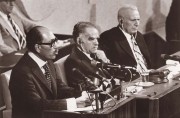 On November 20, 1977, Egyptian President Anwar al-Sadat made an historic speech before Israel’s Knesset, or Parliament, becoming the first leader of an Arab nation to speak there. He was also the first of Israel’s Arab neighbors to publicly say anything like these words: “Today I tell you, and I declare it to the whole world, that we accept to live with you in permanent peace based on justice.”
On November 20, 1977, Egyptian President Anwar al-Sadat made an historic speech before Israel’s Knesset, or Parliament, becoming the first leader of an Arab nation to speak there. He was also the first of Israel’s Arab neighbors to publicly say anything like these words: “Today I tell you, and I declare it to the whole world, that we accept to live with you in permanent peace based on justice.”
By 1977, Israel and the nearby Arab states had fought four wars in less than 30 years. Sadat himself had been a principal architect of the most recent conflict, the Yom Kippur War of 1973. That conflict ended when Egypt, Syria, and Israel accepted a United Nations–imposed cease-fire. This time, though, the uneasy peace was not followed by yet another war. Sadat failed in peace talks to regain control of the Sinai Peninsula, which Israel had occupied in 1967. To break the deadlock, on November 9, 1977, he stunned the world by telling Egypt’s Parliament that he was willing to travel to Israel to negotiate peace. No Arab state had ever recognized Israel’s existence, let alone sent a leader to the Jewish state. Israel quickly accepted his offer, and arrangements for the historic visit were made.
Sadat’s bold move set in course discussions that resulted in the Camp David Accords the following September, and a peace treaty in early 1979—the first treaty signed by Israel and an Arab nation. Both Sadat and Israeli Prime Minister Menachem Begin received Nobel Peace Prizes for their historic agreement. While Sadat was hailed across the world, he was less well received in the Arab world, however. The Arab League denounced Egypt in September of 1978, and Sadat was assassinated in his homeland by radical Islamists because of his overtures to Israel and the western world.
“This Day in World History” is brought to you by USA Higher Education.
You can subscribe to these posts via RSS or receive them by email.





